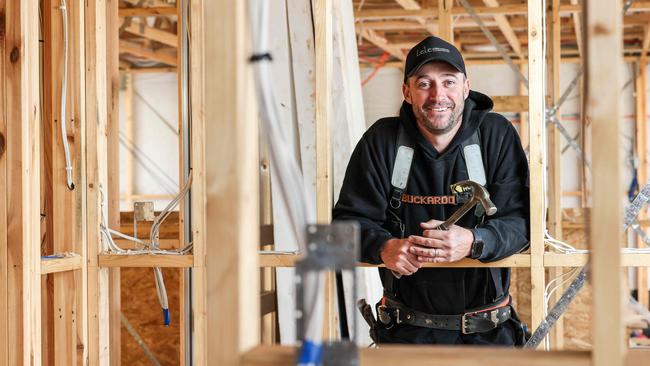SA Government investing in jobs for the future to ease state housing crisis
Training job-ready workers is a key part to building SA’s housing future

SA News
Don't miss out on the headlines from SA News. Followed categories will be added to My News.
A State Government investment in jobs for the future, including offering more training courses aligned to the building and construction industry, is the key to alleviating South Australia’s housing pressures.
Five technical colleges – three in metropolitan Adelaide and two in regional South Australia – are being built at a cost of $208.8 million. The colleges – at Findon, Tonsley, Modbury Heights, Mount Gambier and Port Augusta – will support school students in Years 10-12 to complete their SACE while undertaking vocational education and training (VET) in specialist facilities.
“This investment provides students with the chance to train while they’re in school so when they leave school with their SACE they have a head start into their career,” says Clare Feszczak, executive director, Student Pathways and Careers, Department for Education. “It’s brilliant for those students who have an interest in the industry and want to start their apprenticeship in Year 12 and fast-track to a well-paid job.”
Findon Technical College opened in January this year, while Port Augusta Technical College is scheduled to open in semester two 2025, with the remaining three opening in 2026. “Four of the five technical colleges will offer building and construction pathways to help meet the workforce skills needs of the housing industry,” Feszczak says. “Students completing the building and construction training program will be set up for successful, lucrative careers in an industry with high demand for skilled workers”.

The training programs are co-designed with employers to ensure students are learning the work skills employers actually need. Students will learn in workplace-like facilities using industry standard equipment to receive real-life, hands-on experience with the equipment and technologies used in industry. These employers are guaranteeing employment for students who complete the programs and meet industry requirements.
“The technical colleges are the best example of a high school program where students are fully immersed, learning with employers and building workplace skills to accelerate their career,” Feszczak says. “Students can start in a technical college in Year 10 and be full-time in an apprenticeship in Year 12, reducing the overall time to train and being paid for training and working in the industry.”
The high demand for skilled tradespeople ensures that those starting off in the building and construction industry are guaranteed job security for life. “There is so much demand for good tradespeople,” Feszczak says. “Having a trade and being a qualified tradesperson is a ticket to a career for life, and tradespeople are paid really well. You don’t need to stop at becoming a tradesperson – you can set up your own business or go into management. It’s a career for life and a great opportunity for young people.”
Pathways to construction careers

Educational pathways to apprenticeships are the key to addressing South Australia’s skills shortage, a construction expert says.
Chris Langford, a qualified carpenter with more than 20 years’ experience in the industry, has employed apprentices for the past five years and currently has three on the books, two sourced from Master Builders Association and the other hired privately.
“It’s about having hands on the job,” he says. “There’s a shortage of tradespeople out there so we want to train these young people up to become tradespeople down the track.
“If you don’t have apprentices coming through, you won’t have the skilled labour to build homes.”
Langford acknowledges training a new apprentice can be “a juggle” but insists the long-term rewards outweigh any initial challenges.
“Everyone has to start somewhere. I was an apprentice at one point – we’ve all been there,” he says. “It’s definitely a juggle training someone while you’re working but you hope that once they’re trained they’ll ease your job.”
The ability to train apprentices and mould them into a required shape is another positive drawcard to helping to build a skilled workforce for the future.
“Employers can teach apprentices what we’ve been taught over the years and build them in our mould,” Langford says. “Ideally you want to get them fresh out of school for their first year and train them how you want them.”
For workers in the building and construction industry, the benefits once qualified are endless.
“A lot of students might think they don’t want to be on an apprenticeship wage straight out of school but the benefits down the track include the potential of working for themselves or becoming a leading hand for a company,” Langford says.
“I love what I do and hope to help my apprentices to find their passion too, by providing them with a variety of learning opportunities in the carpentry and building industry.”
Better deal for renters and landlords
South Australia’s revamped rental laws present a balanced approach that will benefit tenants and landlords, Real Estate Institute of SA chair Cain Cooke believes.
Cooke says the sweeping Residential Tenancy Reforms – which took effect on July 1 – will enhance security for tenants facing record low vacancy rates while ensuring landlords’ rights.
With Adelaide currently the tightest rental market in Australia – June’s vacancy rate was only 0.7 per cent compared to a national rate of 1.3 per cent, while the average weekly rent for all houses topped $650 – the overhaul is timely.

“The reforms represent the most significant changes to rental laws since the introduction of the Residential Tenancies Act in 1995,” Cooke says.
“They prioritise both tenants and landlords, delivering what we believe to be a more balanced, pragmatic approach.
“REISA has worked extremely hard with the government to ensure that these reforms are not as punitive as witnessed in other markets.”
Cooke says it is pleasing the reforms took all stakeholders into consideration, offering greater security for tenants in a tight market.
“We hope they will enable good tenants to stay in properties for longer and reduce the ability of landlords to unilaterally end a lease for spurious reasons,” he says.
“While protecting tenants, the reforms also ensure landlords’ rights. They ensure that the landlord still has adequate and sufficient grounds to terminate a tenancy if they require the property for their own possession or the tenant is in breach of the lease.”
The key reforms include:
● Prescribed grounds: Landlords now need specific reasons to terminate or not renew a tenancy.
● Extended notice period: The notice period to end a fixed tenancy has increased from 28 days to 60 days.
● Pet guidelines: Tenants can now keep pets in rental homes, with approval and clear guidelines set by landlords.
● Information protection: Tenants’ information is better safeguarded.
● Minimum housing standards: Rental properties must comply with minimum housing standards.
● Support for domestic violence victims: Additional options are provided for victims of domestic violence.
“These reforms aim to create a fairer and more balanced rental market in South Australia,” Cooke says. “The changes build upon previous actions, such as limiting rent increases, banning rent bidding, and raising bond thresholds.”
However, he says while the changes may assist in “limiting spurious rent increases”, increasing South Australia’s housing stock is the crucial ingredient towards alleviating the current rental squeeze.
“The changes won’t free up what is already an extremely tight market – we need to see an overall supply increase.”
Feeling happy at home with feline friends

Landmark rental reforms will make it easier for fur babies and their human families to stay together – and Catherine Mayer couldn’t be happier.
As the owner of three cats – Moo, Ollie and Hamilton – the 31-year-old Flagstaff Hill woman says securing rental accommodation has proved more difficult in the past because of her feline friends.
However, she says the State Government’s moves to relax restrictions on tenants keeping pets in rental properties will come as a “massive relief” for those who may have been forced into making some otherwise heartbreaking decisions.
As a member of the volunteer program team at the RSPCA, Mayer constantly sees animals looking for a new home after being squeezed out because of tough pet rental restrictions.
“It’s really, really difficult to get approval for a rental, especially for pet owners,” she says. “The general high level of demand now is one thing, but when they know you’ve got pets, it’s like an easy reason to cross you off the list straight away.
“This means less people are going to be homeless or have to surrender their pets. We see quite a lot of it here at the RSPCA. And I might have been in the same position ... we were really lucky to find a place that would accommodate the cats.”
Under the recent changes, a tenant who applies to keep a pet in a rental property cannot have their request “unreasonably refused”.
For their part, the tenant must agree to comply with any reasonable conditions imposed by the landlord, including requiring a pet be kept outside of the rental home if it is not ordinarily kept inside. A landlord can also require that carpets be professionally cleaned at the end of the tenancy if the pet is permitted inside.
If a tenant does not believe the conditions imposed by a landlord are reasonable – or they have had their request to keep a pet unreasonably refused – they may appeal to the SA Civil and Administrative Tribunal.
Mayer struggled for almost a year to find a rental place closer to her work at the RSPCA’s O’Halloran Hill animal care centre. “Most places would be no pets so finding a property that was pets negotiable and pets accepted was a big issue,” she says “And even then you were competing against every other pet owner who was looking for a place.
“These reforms will make life easier for pet owners. It’s definitely a step in the right direction.”
READ MORE:
Room to grow: Housing Roadmap a blueprint for greater home security for South Australians
New public housing and more streamlined planning process for South Australian homes
Originally published as SA Government investing in jobs for the future to ease state housing crisis


